Quality vs. Cheap Sauna...What's the Difference?
Sweating it out in a sauna is a great way to unwind and decompress after a long, hard day’s work. Spending time in a sauna on a regular basis can also offer you amazing health benefits in the long run. However, with so many saunas on the market today, you might be wondering as to how you can separate the wheat from the chaff and choose one that suits your needs best.
In this guide, we take a look at the factors that separate high quality saunas from cheap, low quality ones.
8 Factors to Consider When Comparing
1. Quality of Construction
This is one of the primary differences between high quality saunas and the cheap ones you can find on Amazon, eBay, Wayfair and other places. High quality saunas are made with furniture grade wood and have thick wall panels that can withstand the hot and cold temperature swings.
Cheap saunas, on the other hand, are made with low quality wood with knots and have thin wall panels that are prone to splitting and warping over time.
2. Type of Wood Used
This is an important factor to be considered as the lifespan of a sauna generally depends on the type of wood used.
High quality saunas are usually made of premium wood like red cedar, hemlock, and aspen.
Red cedar is known for its natural aroma and exceptional beauty. Hemlock is known for its cellular properties and its ability to expand and contract naturally to withstand temperature swings.
Aspen is known for its non-toxic properties and durability. Other choices include basswood, poplar, and eucalyptus, which are less expensive and are ideal for those on a budget.
Cheap saunas, on the other hand, are made of oak, pine, spruce, and birch, which are inferior to the aforementioned types of woods in terms of quality and lifespan.
Moreover, manufacturers of cheap saunas often tend to cut corners by using low-quality wood with knots, which is not likely to withstand the drop and increase in surface temperature and is prone to splitting, cracking, and warping.
 |
 |
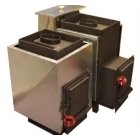 |
3. Type of Heater Used
This is quite possibly the most important factor you need to consider while choosing a sauna. There are four different types of sauna heaters available – wood-fired heaters, gas or propane heaters, electric heaters, and infrared heaters.
Wood-fired Heaters –The oldest type of sauna heaters, wood stoves are still popular as many people seem to love the smell of wood smoke and the ‘toasty warm’ sensation they produce. They are a good choice for outdoor saunas. The only downside with these heaters is that the heat generated can be difficult to regulate.
Gas Heaters – Gas or propane stoves heat up the sauna much faster than wood burning heaters. The heat generated is also easier to regulate. They are, however, more expensive as you need a qualified technician to install the gas lines.
Electric Heaters – These are the most common type of heaters used in saunas today. Saunas with electric heaters usually have digital controls that allow you to regulate the surface temperature and heat quite effectively.
Infrared Heaters – They are better than traditional heaters in the sense that they offer a number of health benefits. They relieve stress, detoxify your body, promote healthy weight loss, and lower the risk of heart disease. Since they heat your body directly rather than heating up the entire room, the surface temperature inside an infrared sauna is lesser than that of a traditional sauna. So, you will sweat more and also find it easier to breathe.
There are two types of infrared heaters available – carbon and ceramic. While they are both known to offer a wide range of therapeutic benefits, they differ in terms of lifespan and the kind of heat they produce. Carbon heaters generally last longer than ceramic ones.
They produce gentle, therapeutic heat which is ideal for a long, relaxing session while ceramic heaters produce intense heat which will have you sweating buckets in a short time.
4. Non-Toxicity
High quality saunas are generally known for their non-adhesive construction, without using any resins, epoxy glue, or allergic materials. It is not the case with cheap saunas.
This is one of the main reasons why people choose high-quality saunas over cheap ones despite the difference in price tag. What's the point of using a sauna of you are breathing in toxic fumes the whole time?
5. EMF Rating
This again is a key factor which separates premium quality saunas from low quality ones. Low-quality infrared heaters tend to produce high levels of EMF (electromagnetic fields), which are hazardous to health and can increase the risk of cancer.
High-quality heaters, on the other hand, have a number of built-in safeguards to ensure extremely low, virtually undetectable levels of EMF.
6. Ease of Assembly
One of the hallmarks of high-quality saunas is that they are easy to assemble and disassemble. The panels fit tightly and securely and there are no air leaks.
Cheap saunas, on the contrary, generally have uneven, poorly cut panels that need to be forcefully clamped together. So, they warp and bow and tend to break down over time.
7. Safety Certifications
This is one of the easiest ways to separate high quality saunas from cheap ones. Leading sauna manufacturers proudly flaunt their safety certifications and third-party testing results to instill a sense of confidence in their customers.
So, before you buy a sauna, make sure you visit the manufacturer’s official website and see if their products are tested and certified by reputed agencies like Intertek, CSA (Canadian Standards Association), and CE (European Conformity).
8. Sustainability
More and more manufacturers of high-quality saunas are making it a point these days to only use eco-certified wood. They do not tend to waste wood and try to use every inch of the lumber to build a 100% green product.
Some of them even go to the extent of planting a tree every time they remove one. Many people tend to buy saunas from such manufacturers to do their part towards environmental protection and sustainability.
Cheap Sauna vs. Quality...Summary
We hope you now have a good idea as to what separates high-quality saunas from cheap ones.
Obviously, higher quality saunas will cost a bit more, but it goes way beyond that when it comes to finding the best one.
Look at the type of wood, the quality of construction, the type of heater, materials used, EMF ratings, certifications and if the company focuses on sustainability and preservation.
Considering all of these factors you can definitely narrow your choices down considerably.
Featured Sauna Building Guide

The ultimate guide to planning, building and owning a home sauna.
Infrared Saunas
Sauna Heaters
How to Install a Wood Sauna Heater
Sauna Kits
Buying Guide
